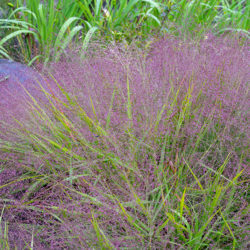Etymology
Eragrostis is Greek for love (Eros) and grass (grostis); spectabilis is Latin for spectacular or showy.
Native Habitat
Sunny locations with dry, sandy soils.
Garden Uses
Pest free. Showy in rock gardens, or massed in dry, sunny borders, slopes, or meadows, where it naturalizes easily. Excellent in dry arrangements.
Overview
An ornamental native grass found across North America. It can reach a height and width of 2 feet. Its summer bloom is a showy, cloud-like reddish-purple. It is generally hardy, easily tolerating drought, black walnut trees, and air pollution, though not shade or wetlands. Spreads easily by both self-seeding and rhizomes.
Leaves and Stems
Leaves are flat and coarse, predominantly basal, and green in summer, turning to browns in autumn. Blade height is about 10 inches. Stems are jointed and hollow between joints.
Flowers
Softly reddish-purple, tiny florets appear in late August-early September in loose, airy tip inflorescence on thin stems attached to main stems. This gives the cloud-like appearance and raises the plant height to about 2 feet. These inflorescences fade to brown in autumn, and then break off and blow across the ground like a tumbleweed.
Fruit/Seed
Seeds are tiny and brown, and spread by wind dispersal.
Animal Associates
Deer resistant. Beneficial to multiple butterfly species.
Propagation
Clump division or by seed.
Ethnobotanical Uses
We found no references to ethnobotanical uses in the literature we reviewed.
Garden Location
Library Garden (see garden map)
Sources
Lady Bird Johnson Wildflower Center
Plant Profile by Kate O’Dell

